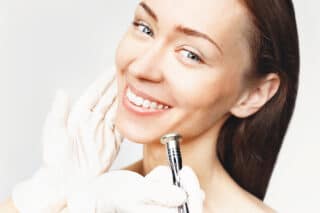
More Beauty Skin Care & Gorgeous Smiles Articles
Exfoliation Is the New Cleansing Step

Begging at puberty, skin’s cellular turnover slows down significantly. During infancy, cells are shed daily; during puberty, once every 10-14 days; and by the age of 30, once every two months. This dead skin buildup clogs pores and increases the appearance of fine lines, wrinkles and discoloration. Exfoliating improves skin’s appearance by unclogging pores to restore flow of natural moisture agents to the surface, ridding the surface of blackheads and debris and reducing potential breakouts, sloughing discolored skin cells to fade dark spots, reducing the appearance of pores and scarring, minimizing fine lines and wrinkles, clearing the surface to better absorb products, and stimulating skin to produce collagen and elastin.
Based on this benefits, exfoliation should be a regular part of every skin care routine and a primary step in every professional treatment.
Types Of Exfoliation
Physical exfoliation manually removes dead skin using a hard matter to disrupt or scrub surface cells while chemical exfoliation utilizes hydroxy acids or enzymes to remove dead skin cells.
- Physical Exfoliation – Micro-granules are ultra-fine particles derived from natural elements like seeds and crystals.
- Chemical Exfoliants – Alpha hydroxy acids are derived from fruit, nuts, milk or sugar. Lactic acid and glycolic acid are among the most common.
- Mechanical Exfoliants – Microdermabrasion uses a handheld device to sandblast skin with tiny particles and vacuum suction the dead skin away.
- Dermaplaning is a non-invasive procedure in which a blade removes excess vellus hair, and also exfoliates the epidermis by scraping the surface.
Combined exfoliating techniques improve the outcomes greater than stand alone techniques. Here are some general rules of thumb for selecting exfoliators when combining peels with mechanical treatment by skin type:
- Combination Skin – Combined chemical and mechanical exfoliation is perfect for this skin type. A glycolic acid chemical peel prior to mechanical exfoliation diminishes oil in the T-zone and removes surface debris, discoloration, and dry skin patches.
- Acne – A mechanical exfoliator may be too rough for irritated skin and can potentially spread bacteria, making breakouts worse. Prior to microdermabrasion a chemical peel with a beta hydroxy and glycolic acid combination can reduce inflammation and kill bacteria without transepidermal water loss or over-drying skin.
- Oily Skin – Traditionally, oily skin tolerates exfoliation well, so a peel in advance of mechanical exfoliation will allow a deeper penetration and resurfacing.
- Dry Skin – Dry skin is less absorbent of moisture-baring ingredients, therefore, a pre-peel preparation removes dead skin cells on the surface, providing better absorbency and improved penetration. Glycolic acid is preferred because it has a smaller molecular size for penetration into dry skin and does not cause transepidermal water loss.
- Sensitive Skin – A combined protocol of pre-peel actually opens up the opportunity for sensitive skin types to be candidates for mechanical exfoliation. By using a light alpha or beta hydroxy acid peel before the procedure, the skin care professional can apply much less pressure and choose the lowest settings for a great outcome.
- Photoaged Skin – A chemical peel of glycolic acid will slough off dull, sun damaged skin cells as well as boost collagen production while minimizing dark age spots.
Written by Margarita Zorkina, Master Aesthetician, Alya Salon & Spa
Other Articles You May Find of Interest...
- Longevity Supplements: Improving Medical Practitioner Care & Functional Medicine in 2024
- Rejuvenate Your Skin: How Cutting-Edge Science Transforms Personalized Skincare
- Five Options for an Improved Neck Contour
- Can You Benefit From Braces?
- Exploring the Safety and Effectiveness of CoolSculpting Treatments
- How to Prepare for Your Visit to the Dermatologist
- What’s the Right Age To Have Cosmetic Surgery?

















